
by Carolyn Gramling Thursday, January 5, 2012
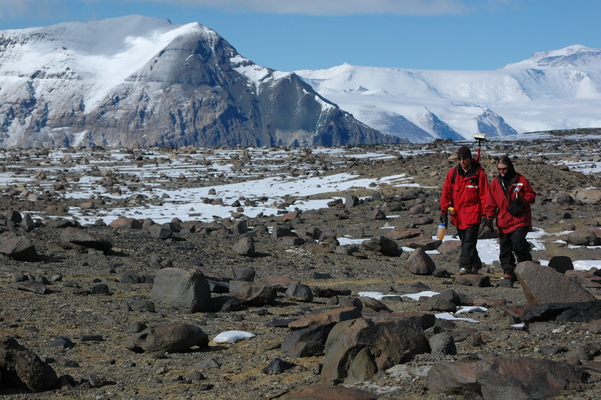
Andrew Podoll (left) and Kelly Gorz, both North Dakota State University geology undergraduates, map the terrain in Antarctica's Dry Valleys. Photo by Peter Rejcek of The Antarctic Sun. Dry Valleys Productions
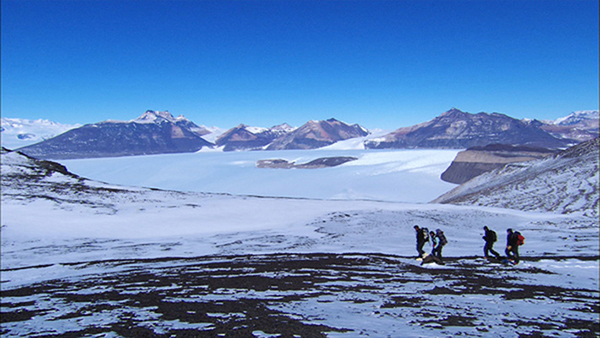
The four geologists in 'Ice People' go on a hike to find fossils and volcanic ash. Taylor glacier is in the background. Dry Valleys Productions
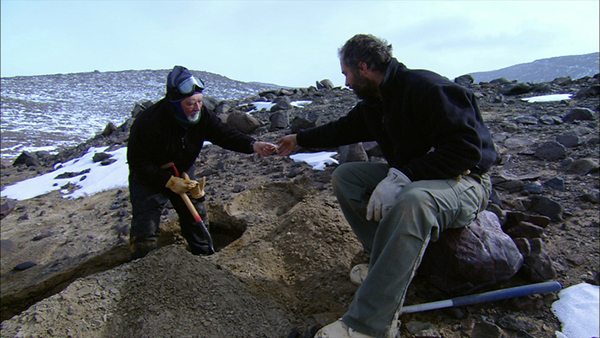
Allan Ashworth (left) and Adam Lewis look for fossils in the Dry Valleys. Dry Valleys Productions.
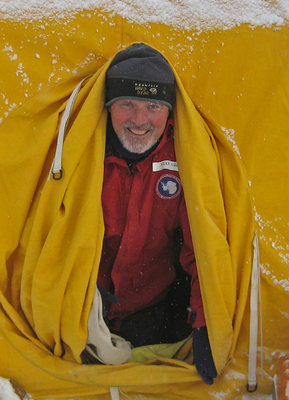
Allan Ashworth exits his tent in the Dry Valleys of Antarctica. Photo by Adam Lewis. Dry Valleys Productions
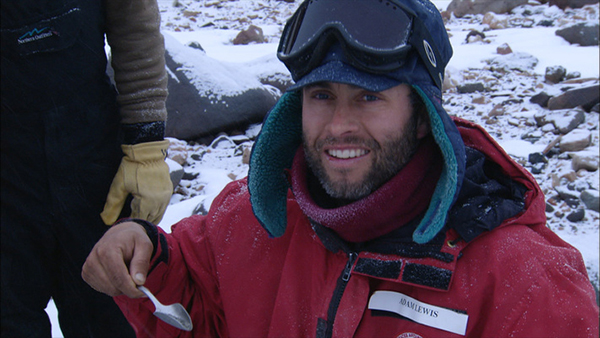
Adam Lewis holds a spoon full of volcanic ash discovered in the Dry Valleys. Dry Valleys Productions
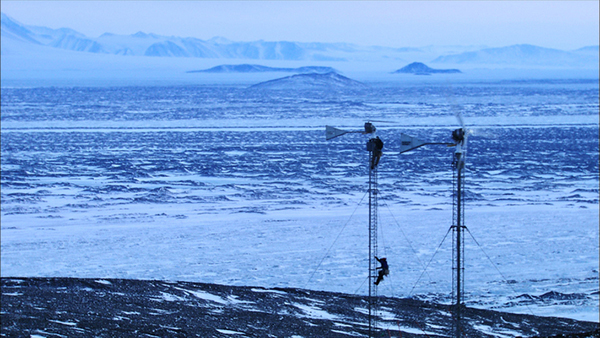
Riggers Andrew Asher and Michiel Lofton repair a wind generator tower after six months of winter darkness. Dry Valleys Productions.
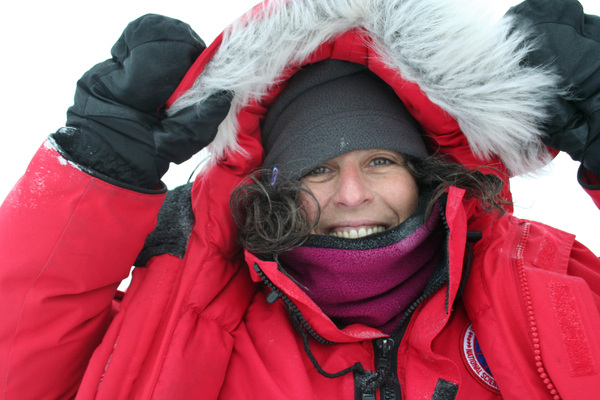
Director Anne Aghion during the filming of 'Ice People.' Richard Fleming
“We do not come to Antarctica because we are in love with Antarctica. We come to Antarctica because we want a mystery to solve, and we love a challenge. And there’s one here.”
With those words, Adam Lewis, a glacial geologist from North Dakota State University, sums up the human story at the heart of “Ice People,” an austere, unpretentious and often gorgeous documentary about scientists working at the end of the world.
Although set in Antarctica, the movie features no charismatic, lovable penguins. Nor is it primarily about showing the stark beauty of the frozen continent. Instead, the film offers a rare window into the daily life, daily inconvenience, daily wonder and daily cold of the scientists and support staff who voluntarily spend months at a time in Antarctica, dubbing themselves “ice people.” Through pensive visual snippets and thoughtful interviews, the film tells a compelling human story that serves as a counterpoint to the iconic Antarctic images of penguins and ice.
“Antarctica is very much at the center of the film — it’s a character,” says director Anne Aghion. Aghion and her crew, a cameraman and a sound recordist, spent four months on the continent, including seven weeks tagging along with four scientists as they camped in the Dry Valleys, 130 kilometers from McMurdo Station. The Dry Valleys, in the Transantarctic Mountains, are starved of moisture and are thus devoid of snow and ice; they are the closest place on Earth to the barren terrain of Mars. The Valleys’ exposed rock sequences are an irresistible lure to scientists searching for fossils or other geological evidence of the continent’s climate history.
On this trip, Lewis and North Dakota State University paleoecologist Allan Ashworth are determined to dig into that history. To help, they bring along two of Ashworth’s undergraduate students. What they found during this expedition was one of the most significant discoveries in recent Antarctic research — and what the film provides is a unique glimpse into the sometimes invigorating, sometimes agonizingly slow process of the fieldwork behind such discoveries. We watch the scientists spend many of their days digging (or, frequently, jackhammering) the frozen ground, hunting for telltale fossils, while the students trudge across the landscape in their uniform red parkas, painstakingly mapping the terrain with GPS.
Then the team discovers a perfectly preserved leaf fossil in Taylor Valley. The leaf, it turns out, is part of a growing body of freeze-dried fossil evidence, including mosses, diatoms and a type of marine crustacean called an ostracod, that the team has collected on this trip. Together, they later announced, this evidence suggests that Antarctica underwent a major climate change 14 million years ago, from relatively warm tundra to frozen polar glaciers. In the film, the excitement of the leaf discovery soon evolves into a rosy but tired glow of triumph. It’s a start, but there’s more work to do. Still — “that’s a sweet leaf,” Lewis says softly, admiring the fossil.
The scenes in which we see the team dealing with how to handle the minutiae of life in this environment are perhaps even more compelling, from a human standpoint. Periodically, the scientists must wrestle with frozen paraffin stoves, or throw on heavy clothing just to go outside to fill up a canister of fuel from a communal container or dump their waste into yet another communal receptacle. And some of these details are curiously fascinating: One student explains that after days of not showering, dried skin tends to come off in sheets. And, she laughs, seeing a revered advisor enter a tent with a snot-sickle frozen to his face was kind of a shock.
But physical discomfort aside, how people survive emotionally and psychologically in extreme situations is really at the heart of her story, Aghion says. Aside from the work, living in Antarctica, the film seems to be saying, can be both profoundly beautiful and profoundly boring. The recurrent images of tiny yellow tents and red parkas set against a vast white/brown rocky landscape serve to highlight how cut off these people are from the world, albeit temporarily. They handle this differently: Given a rare opportunity to chat with family members on a precious satellite phone at Thanksgiving, one scientist talks briskly and cheerfully, filling the frozen air with chatter; another cries quietly. Huddled in a communal tent for dinner, the team carefully debates politics. A student notes that it’s sometimes a struggle to find new things to say to the same handful of people when everyone’s “having the same day.”\
There are few scenes filmed at the relatively cozy McMurdo Station, which is largely devoid of scientists over the Antarctic winter, but they are equally hushed. Swept by blowing snow, McMurdo resembles a western ghost town amid a vast desert of ice. There are rare moments of life, such as when half a dozen guys run around in the snow playing football in the first light of the sun, a momentous morning that marks the end of the long, dark winter months. Much of the time, though, the communications and support staff seem subdued, alternately bravely climbing onto wind generator towers to make repairs or hanging out or reading in a common room when the weather turns foul. “Sometimes we forget there’s science going on,” one staff member says, listening to the howling outside.
The film is filled with lovingly photographed images of gorgeous, empty white wastes that help set the mood and provide a lot of shivery context. But I’d have enjoyed even more human contact, glimpses of and conversations with the people who bring the landscape briefly to life and warmth, even when huddling inside their tents or staring moodily at the walls of McMurdo. Still, through its spare storytelling “Ice People” weaves a meditative spell that lingers long after the movie ends.
“Ice People” is currently being screened at venues around the world; for a list of upcoming screenings, visit the movie’s website, where you can also purchase the DVD. “Ice People” will also air on the Sundance Channel this spring.
© 2008-2021. All rights reserved. Any copying, redistribution or retransmission of any of the contents of this service without the expressed written permission of the American Geosciences Institute is expressly prohibited. Click here for all copyright requests.